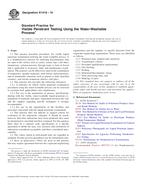We need your consent to use the individual data so that you can see information about your interests, among other things. Click "OK" to give your consent.
ASTM D6669-12
Standard Practice for Selecting and Constructing Exposure Scenarios for Assessment of Exposures to Alkyd and Latex Interior Paints
STANDARD published on 1.4.2012
The information about the standard:
Designation standards: ASTM D6669-12
Note: WITHDRAWN
Publication date standards: 1.4.2012
SKU: NS-36089
The number of pages: 6
Approximate weight : 18 g (0.04 lbs)
Country: American technical standard
Category: Technical standards ASTM
The category - similar standards:
Annotation of standard text ASTM D6669-12 :
Keywords:
activity pattern, air change rate, building volume, emission profile, exposure assessment, exposure scenario, indoor air quality, inhalation exposure, paint, product application, risk assessment, Alkyds/alkyd materials/applications, Assessment/Assesors, Exposure tests--atmospheric, Interior paints/coatings, Latex paints, ICS Number Code 19.040 (Environmental testing), 87.040 (Paints and varnishes)
Additional information
| Significance and Use | ||||||||||||||
|
Increasing attention is being paid to human exposure to airborne chemicals from products or materials used indoors, for two reasons: Individuals spend substantial fractions of their time indoors. Such exposures can occur repeatedly throughout one's lifetime. The primary objectives of this practice are as follows: To list the elements that need to be considered in developing a scenario to describe how exposure occurs to chemicals emitted from alkyd or latex interior paints. To discuss procedures and alternatives for choosing and describing these elements. Elements of an exposure scenario, in turn, are used to practice a subsequent step of estimating exposures through monitoring studies or computer modeling exercises. Once exposures have been estimated, the results can be used to assess the potential impacts of a specific paint formulation on the health of exposed individuals, or to compare the relative impacts of alternative formulations. Estimation of exposures, or comparisons of estimated exposures across alternative paint formulations, can lead to development of environmentally preferable products by minimizing adverse health effects for exposed individuals. |
||||||||||||||
| 1. Scope | ||||||||||||||
|
1.1 This practice provides procedures for constructing scenarios for assessment of inhalation exposure to airborne emissions of chemicals released from alkyd or latex paints that are used indoors. 1.2 The indoor environments covered in this practice, in terms of considerations for developing exposure scenarios, are residences and office buildings. 1.3 Elements of the exposure scenarios include the product and chemical(s) to be assessed, the indoor environment where the product is applied, application of the product, chemical emissions during and after product application, and location/activity patterns of individuals who may be exposed to the airborne chemical emissions. 1.4 Steps to be performed after developing exposure scenarios, such as monitoring, modeling and exposure/risk assessment, also are described. 1.5 Units—The values stated in SI units are to be regarded as standard. No other units of measurement are included in this standard. 1.6 This standard does not purport to address all of the safety concerns, if any, associated with its use. It is the responsibility of the user of this standard to establish appropriate safety and health practices and determine the applicability of regulatory limitations prior to use. |
||||||||||||||
| 2. Referenced Documents | ||||||||||||||
|
Similar standards:
Historical
1.6.2013
Historical
15.2.2010
Historical
15.11.2011
Historical
1.10.2013
Historical
1.7.2013
Historical
1.3.2011
We recommend:
Technical standards updating
Do you want to make sure you use only the valid technical standards?
We can offer you a solution which will provide you a monthly overview concerning the updating of standards which you use.
Would you like to know more? Look at this page.



 ASTM E1417/E1417M-13..
ASTM E1417/E1417M-13.. ASTM E1418-10
ASTM E1418-10 ASTM E171/E171M-11..
ASTM E171/E171M-11.. ASTM E2149-13a
ASTM E2149-13a ASTM E2899-13
ASTM E2899-13 ASTM E698-11
ASTM E698-11
 Cookies
Cookies
